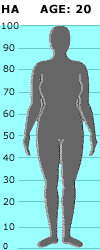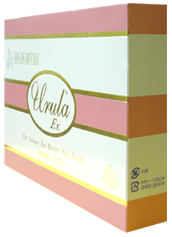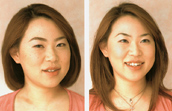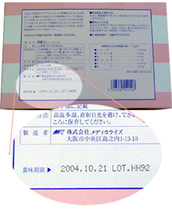|
Biological Functions and Health Benefits
1. Water retention
Retention of water is one of the most important biological functions
of Hyaluronic Acid* in skin and other
tissues. In skin, HA and other sulfated glycosaminoglycans (DS,
CHS, etc.) combined with collagen and elastin, form ECM (extracellular
matrix) containing large amount of water. The gel like ECM filling
up the extracellular spaces between cells of skin makes skin soft,
smooth, moist, elastic and fine. While becoming older, HA content
in human skin decreases, result in the loss of water. As a consequence,
ECM contracts, arrangement of cells becomes closer, collagen becomes
de-natured and hardened, skin becomes dry and rough, wrinkles form.
So the water retention function of HA serves a very important role
in healthy skin.
2. Medium and environment of cell metabolism
The ECM formed by HA, DS and CHS, is the medium of normal metabolism
(proliferation, migration, differentiation) of cells, through which
nutrients and wastes are transported.
3. Ion adjustment
Each disaccharide unit of long chains of HA, DA and CHS has a carboxylic
group, which contain an anion. So there are great number of anions
meanly arranged along the long molecular chain, and are called polyanions.
The polyanions serve as cation exchanger, and adjust the movement
and concentration of cations around them.
4. Improves wound healing and less Scarring
Studies have shown that the presence of HA improves the wound healing
process and the quality of the tissue repair is higher with less
fibrous scarring. HA performs regulatory and structural functions
during wound healing by stimulating or inducing cell motility, and
activating and regulating many functions of blood’s inflammatory
cells, as well as connective tissue resident cells. The important
role played by HA in the scarless nature of fetal wound healing
has been well documented. Adult wound healing is a reparative process,
accompanied by scar formation. In contrast, wound healing in the
early gestation fetus is regenerative in nature with the resulting
neotissue being free from visible scarring. Fetal wound healing
is characterized by an elevated and persistent presence of HA at
the wound site compared to adult granulation tissue.
5. Prevent UV light damage of skin
HA, DS and CHS, effective scavengers of free radicals, may also
serve a protective role in epidermis by scavenging reactive oxygen
species generated by ultraviolet radiation. The rapid turnover of
HA may help to remove and clear noxious compounds from epidermis.
DS can increase the density of skin cells, and prevent UV light
from invading into skin. For the inflamed skin by UV light, DS inhibits
swelling and the formation of bled. Studies showed that UV light
irradiation stimulate the biosynthesis of DS and HA in skin, and
increase the contents of DS and HA in skin compensatively. As consequence,
HA, DS, and CHS can inhibit the formation of fleck or sunspot induced
by UV light in sunshine.
6. Enhance the functions of blood capillary
As one of the important components of blood capillary, DS can enhance
the functions of blood capillary in skin, increase blood circulation,
and prevent acidification of blood and the formation of fleck.
7. Activation of skin cells
DS can activate the metabolism of skin cells, promote division and
proliferation of basal cells, normalize the life circle of epidermis
cells and expel fleck in early period, inhibit keratinization of
skin.
8. Lubricating effect
With long and linear chains, HA in solution of ECM exhibits very
high viscosity and excellent lubricating effect in human body. In
fact, the main ingredient of synovia is HA. In just about all human
exercises, muscle cells need lubrication to perform stretching out
and drawing back.
9. Pain relieving effect
HA can cover the pain receptors on nerve cells, and has pain relieving
effect. When given to arthritis patients, CHS reduce the joint pain
by inhibiting free radicals that degrade joint cartilage and collagen.
CHS also improve blood circulation to joints, which enables antioxidants
and glucosamine to enter inflamed joints to stimulate the repair
process required for the regression of osteoarthritis.
10. Inhibition of thrombin
Dermatan sulfate expresses its anticoagulant activity by catalyzing
the inhibition of thrombin as it is formed in plasma. It specifically
activates heparin cofactor II (HCII), a plasma protease inhibitor
which inhibits thrombin but not other proteases involved in hemostasis.
|
|
| |
|
In a nut shell:
Hyaluronic acid (HA) content in
human body decreases as we grow older. If the relative HA
content in the body of a 20-year-old human is designated as
100, it will decrease to 65, 45, and 25 respectively when
the age is 30, 50, and 60 years old.
Oral administration of Urula HA-DS can effectively recruit
HA, DS, and CHS in the body, restore many important biological
functions, thus ward off the aging process.
|
 |
| HA content
in human body decreases as we grow older. |
| |
 |
|
Urula users reported
major improvements on these typical aging related problems:
age spots, skin wrinkles, hair loss, joint pain, muscle ache,
hemorrhoids, and deteriorate eyesight. Some reported better
energy level and faster wound healing time.
|
| |
 |
| Urula HA-DS is also
an effective beauty and skin care ingredient.
Click on the above photo to see the case studies. |
| |
 |
| Every Urula HA-DS
package has manufacturer’s imprint of Lot Number and Expiration
Date. |
|




